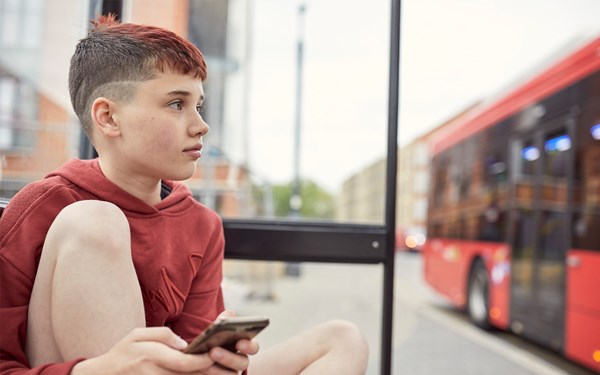Types of gender identity
Some of the terms a young person or child might use to describe their gender identity include:
- Trans or transgender: this is when someone feels their gender is different from, or doesn't sit comfortably with, the sex they were registered at birth.
- Non-binary, gender diverse and genderqueer: these are umbrella terms for people whose gender identity doesn't sit comfortably as man or woman. Instead, they may identify with some aspects of one or both of these identities, or identify with neither. Additionally, some people may identify as genderfluid and see their gender as flexible, rather than a fixed identity.
- Cisgender: this is when someone's gender identity is the same as the sex they were registered at birth.
How to support a child
Sometimes it can be difficult for you if your child is questioning their gender identity, or comes out as transgender or non-binary. You may feel unsure how to help them, not know what to say, or how to relate to what they're going through. You may feel angry or upset. You might also find it hard to know how to talk to your child's school, or explain things to extended family who may not be supportive.
Whatever you're feeling, it's important to remember that transitioning or questioning their gender identity can be a stressful and lonely experience for some children and young people. They may feel like no one understands what it's like for them, worry about being accepted or about how their friends and family will react.
You can seek support via the NSPCC Helpline if you are concerned about your child.
Your child can seek support from Childline.
We also have some advice on how you (parents and carers) can support your child:
Listening without judgement can be a great way to show your support. Some children can feel like no one understands what they're going through, or may be worried about how you'll react, so simply listening can help them to feel accepted and supported.
Be sure to show you are actively listening by summarising back to your child what they're telling you. Try to ask open questions that don't have yes or no answers, and try not to interrupt them. It's important to keep the conversation about their feelings and concerns, and to avoid offering opinions or advice.
Watch NSPCC Learning's helpful, short video on active listening.
Some children or young people may find it difficult to talk about how they're feeling about their gender identity. It can take a lot of courage for them to start the conversation and sometimes they may not be comfortable sharing everything straight away. Be patient and try not to rush them. Instead, let them know that you're there if they want to continue the conversation at a different time.
It's natural for children and young people to explore and develop their identities.
It can help to remember that gender identity is just one part of this and doesn't define your child. For some children or young people, their gender identity may stay fixed. But your child may also be questioning their gender, and it's important to understand that their gender may change over time.
The most important thing you can do is give them the time and space to explore or express their identity and accept them as they are now.
Young people may want to use pronouns that reflect their gender identity such as 'she' and 'her', while others may prefer gender neutral pronouns such as 'they' and 'them'.
They may also want to change their name. Try to use the correct pronouns and name, or ask if you're unsure. You may also want to ask your child if they'd like you to speak to extended family or their school about the pronouns they prefer, or about a name change.
You might find it hard when your child identifies as transgender or is questioning their gender identity. You might find it challenging to come to terms with your child's gender identity, and you may experience feelings of anger, grief or loss after finding out your child doesn't identify with the sex they were registered at birth. You may also find it difficult having to explain things to your child's school or extended family, especially if anyone is unsupportive.
If you're struggling with this, joining a support group and speaking to other families in similar situations can really help. It can also be helpful to remember that gender identity is just one part of your child's identity, and that they're still your child.
It's also important to reach out to your friends and family members for support where possible. Sometimes just having someone who'll listen can help. Your GP may also be able to help you find support and counselling if you need it.
It can be really upsetting if your child is experiencing transphobic bullying, or being bullied because of their gender identity. This can include things like deliberately refusing to call them by their new name or pronouns, or asking personal, sexual questions.
Bullying someone because of their gender identity is a hate crime and against the law. You or your child can report it online or by calling the police. Call 999 in an emergency, or 101 for information or support.
We also have advice on how to support a child who's being bullied, whether it's happening at school or online. Children and young people can also get advice and support on homophobic and transphobic bullying from Childline.
Worried about a child?
You can contact the NSPCC Helpline by calling 0808 800 5000, emailing [email protected] or completing our report abuse online form.
Gender dysphoria
Gender dysphoria is when someone experiences unease because their gender identity is different from, or doesn't sit comfortably with, the sex they were registered at birth. Gender dysphoria is not a mental illness, but some people may develop mental health problems such as depression or anxiety, as a result of gender dysphoria.
Gender dysphoria can start from a very young age. This could include things like not wanting to wear masculine or feminine clothing. Older children may feel anxious or uncomfortable about the changes that happen during puberty, such as starting their period, or their voice deepening. However, this type of behaviour is reasonably common in childhood and is part of growing up. It doesn't mean that all children behaving this way have gender dysphoria or other gender identity issues.
In 2022/23 Childline delivered almost 3,400 sessions about sexuality and gender identity.
Common themes for children contacting Childline with questions about their gender identity are: anxiety about their feelings, fear of not being accepted, lack of available support, and the time it takes for them to access support services.
Transitioning
Some young people who experience gender dysphoria may decide to transition. Transitioning is the jouney someone takes from presenting themselves as the gender which corresponds to the sex they were registered at birth, to presenting themselves as the gender they feel they are.
Children and young people may choose to do this in different ways and at different stages depending on what they feel comfortable with. Some young people may choose to do this privately or just with close friends and family, before coming out more publicly.
A child or young person's transition may involve changing the way they look or dress. For example, they might want to wear makeup or shave their facial hair. Some children may also want to visit the doctor to get support or discuss their options for medical treatment. Your GP should be able to provide advice and guidance about what options are available to support children and families.
If you're worried about a child who's LGBTQ+
Not all children and young people feel comfortable talking to their parents or carers about their gender identity, or their family may be unsupportive when they do. Children may also be experiencing abuse or neglect at home, and not feel safe to come out.
Adults outside the child's family, such as teachers, sports coaches, or extended family, can provide valuable support. Being able to talk to a safe adult who will listen non-judgementally can really help a young person to feel accepted and less alone.
You may be worried about a child you know who is being bullied because of their sexual or gender identity, or who's experiencing abuse at home. We also know that LGBTQ+ young people are more at risk of grooming and child sexual exploitation.
If any of these things are happening, it's important to get help right away. Our trained helpline counsellors can provide support and advice online or over the phone on 0808 800 5000.
Support for young people from Childline
- Childline 1-2-1 chat - for young people to speak to a Childline counsellor online.
- Message boards - support from other young people with similar experiences.
- Gender identity - advice for young people on gender identity and dysphoria.
- Coming out - support to help young people coming out.
- Homophobic and transphobic bullying - support if a child's experiencing bullying because of your gender identity.
- Ask Sam - young people can write to Sam about anything that's on their mind.






